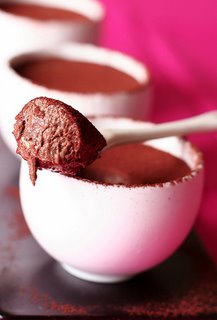 |  |  |
I saw Lulu & Philippe's gorgeous photos this morning and then my RSS feed served up these food photography tips. Here are some others:
- Never use a flash. If you're in a restaurant, choose a table near a window. "The flash flattens everything out," says photographer John Kernick. When that's not possible, choose one of the camera's "white balance" settings; for example, the setting indicated by a light bulb compensates for the yellow tint indoor lights can cast.
- Get in close. "If you fill the frame with the dish, it can make the food look heroic," says photographer James Baigrie. Use a camera's macro setting (often indicated by a flower icon) to bring a part of the dish into sharper focus. Or widen the aperture to reduce the depth of field, which allows you to focus on foreground details—say, the crusty corner on a dish of macaroni and cheese—and keep the background soft.
- Wipe glasses and plate edges. Be sure surfaces are free of smudges and greasy fingerprints, says food stylist Alison Attenborough. In good light, they really stand out.
- Work quickly. The longer it takes to set up a shot, the more salads wilt, sauces congeal. "For food to look delicious, it needs to look fresh," says Baigrie.
- Keep hands steady. In low-light conditions, even the slightest tremor can produce a blurry photograph. Brace your elbows against the table to keep the camera steady. Or try thefoodsection.com blogger Josh Friedland's trick: He often uses the top of a water glass as a makeshift tripod.
- Shoot a lot. "A photo may seem [okay] on the camera's tiny screen," says Chika Yoshizaki, the blogger at shewhoeats.blogspot.com. "But when I get home and look on my computer, it is likely to be out of focus or too bright. So I click away."
- Shoot food as it's being prepared. "Don't get hung up on capturing the quintessential 'final shot,'" says 101cookbooks.com blogger Heidi Swanson. "There are all sorts of great details that emerge throughout the cooking process."
- Know what not to shoot. Some foods are notoriously unphotogenic—for example, a meal that's all one color or dishes with brown sauces.
- Do your homework. For other tips, skim the food-photo discussion boards at flickr.com. —Rob Willey

Aucun commentaire:
Enregistrer un commentaire